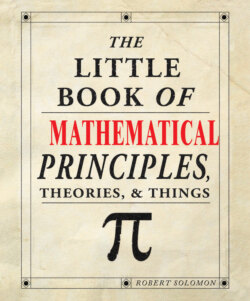Читать книгу The Little Book of Mathematical Principles, Theories & Things - Robert Solomon - Страница 11
На сайте Литреса книга снята с продажи.
c. 3rd century BC Global π
ОглавлениеThe ratio of the circumference of a circle to its diameter.
_______________
The value of π has been found to higher and higher accuracy. It occurs in many places in mathematics besides the measurement of circles.
Circles come in different sizes of course. As the diameter (the length across) increases, so also does the circumference (the length around). The ratio between these two is the same for all circles and it is given the name π (Greek letter p, pronounced “pie”).
All civilizations have needed to find an approximation for π. An early Egyptian value was 4 x (8/9)2, which is 3.16, close to 3.14. In the Bible, I Kings 7, verse 23, the more approximate value of three is given.
The first-known reasoned estimation of π is due to Archimedes in the 3rd century BC. By drawing polygons inside and outside a circle, with more and more sides, he was able to close in on the value of π. With polygons of 96 sides, he found that π lies between 223/71 and 22/7. The latter value is still used. In the fifth century, a Chinese mathematician, Zu Chongzhi (429–501), found the more accurate fraction 355/113.
Further progress was made possible by the development of trigonometry. In the 14th century the Indian mathematician, Madhava, used trigonometry to discover the following series (which continues forever:
π/4 = 1 – 1/3 + 1/5 – 1/7 + …
This can be used to find π, but it is a very inefficient method. Using a variant of the series Madhava was able to calculate π to 11 decimal places.
Until the 20th century all the calculations were done by hand but with the invention of computers, much greater accuracy is possible. In 1949, the ENIAC calculated π to 2,037 decimal places, taking 70 hours to do so. Modern computers have calculated π to well over a million places.
The number π occurs throughout both pure and applied mathematics. Often these applications have nothing to do with the measurement of circles. For example, the equation of the normal or bell curve, which is central to statistics, is:
See: ENIAC, page 181; The Normal Distribution, pages 94–95
